“You want me to enter my credit card for something FREE?” my friend asked, staring at the sales page in disbelief.
I smiled. “Exactly. And that’s precisely why it works so brilliantly.”
The Invisible Funnel – a revolutionary concept I discovered in the Dotcom Secrets book and pioneered by Daegan Smith.
While everyone else begs for emails with freebies, this approach filters for commitment upfront while still delivering exceptional value.
For course creators and coaches drowning in tire-kickers and time-wasters, this strategy is nothing short of transformational.
Imagine your next webinar filled exclusively with serious, qualified prospects – people ready to invest, not just collect free information. You’ll build genuine connections with dream clients who respect your expertise, while simultaneously establishing yourself as an authority they trust implicitly.
By the time you invite them to your premium program, they’re not just willing to invest – they’re eager to (even if you’re just starting out with a modest following and limited offerings).
This guide shows you exactly how to implement this powerful but counterintuitive strategy in your business. Let’s dive in!
What Is The Invisible Funnel?
An Invisible Funnel is a revolutionary marketing strategy created by Daegan Smith where prospects provide payment information upfront for “free” content but are only charged if they find value in what they received.
It’s built on the psychology of reciprocity and completely flips the traditional sales sequence—you deliver value FIRST, then collect payment AFTER customers experience results.
Imagine going to the movie theater and watching an entire movie all the way through, then deciding whether you think it was worth the cost of the movie ticket.
The Origin Story
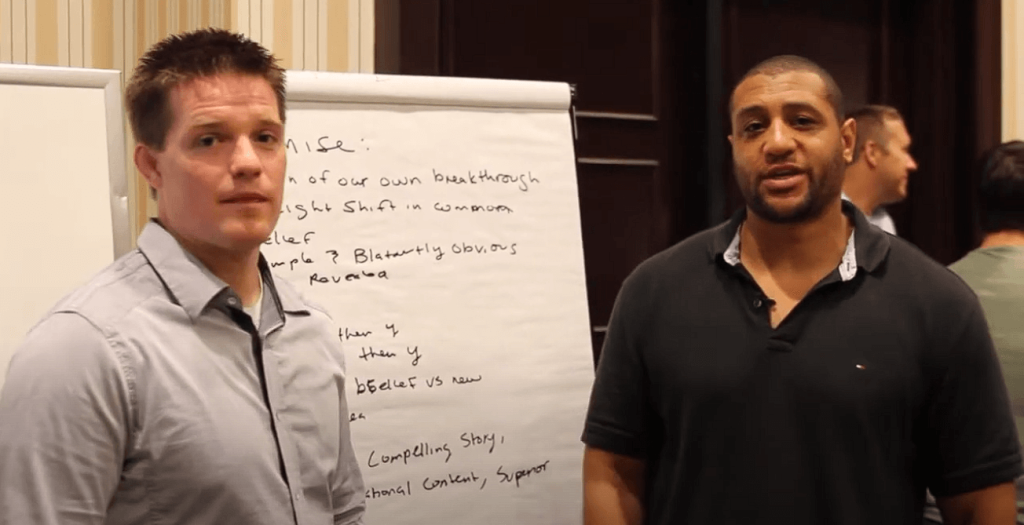
The concept has a fascinating backstory. After attending the Traffic and Conversion event, Daegan Smith and Russell Brunson accidentally walked out of a restaurant without paying for their meal. When they realized their mistake and returned to settle the bill, a lightbulb moment occurred.
Daegan Smith wondered:
- What if we applied this same principle to marketing?
- What if customers could experience the full value of a product or service before deciding if it was worth paying for?
This dinner incident led to what Russell Brunson called “the best selling tool I’ve ever used.”
How Does The Invisible Funnel Work?
The Invisible Funnel completely reverses traditional funnel psychology.
You create a high-value webinar or training and promote it as “free.” Visitors watch your Video Sales Letter, then register by entering their credit card details—but nothing gets charged immediately.
This simple requirement filters out 99% of freebie-seekers instantly.
After registration, you offer a compelling One-Time Offer to boost your Average Cart Value. Then you deliver additional product options on the thank you page to maximize revenue potential.
Now comes the genius part.
Your customers consume your free training.
Then you tell them: “If you found value, do nothing and you’ll be billed in X days. If you didn’t think it was worth it, just let us know and we won’t charge you.”
The results?
Russell Brunson reported 85-90% webinar show-up rates (compared to the industry standard of 20-30%) and substantial upfront earnings from the OTOs alone.
It’s like test-driving a Ferrari for a full weekend before deciding if you want to buy it.
When Daegan and Russell taught this method to other marketers, they saw consistently higher conversion rates compared to traditional models—especially for high-ticket offers.
This approach crushes standard funnels because it leverages psychology instead of fighting it. You’re not selling anymore—you’re simply delivering so much value that payment becomes the obvious next step.
What Are the Benefits Of The Invisible Funnel?
1. Compress Your Sales Cycle
Look at the traditional value ladder in most businesses.
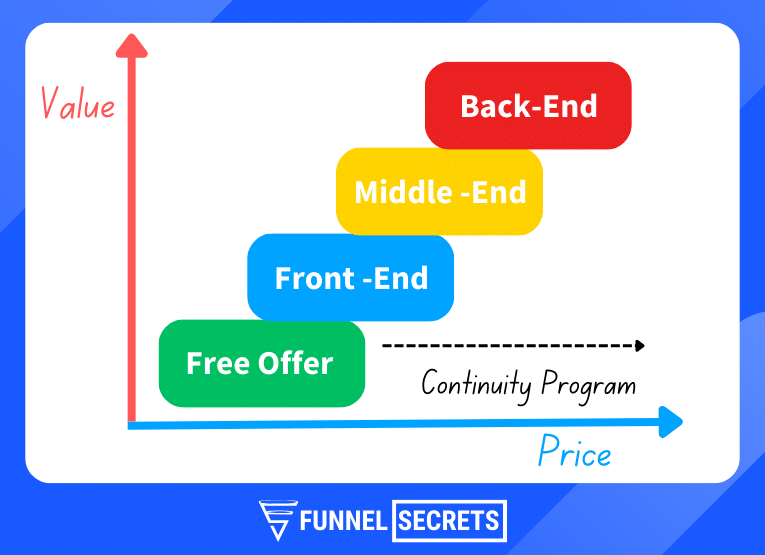
It starts with a free offer, moves to front-end offers (low-priced products), then to middle-end offers, and finally to back-end offers. The psychology behind this approach is building trust step-by-step, which takes time.
The Invisible Funnel dramatically compresses this process.
It starts with “free” but with a payment commitment that activates later, helping you attract more people with the appeal of free content while still generating revenue. You can then offer your back-end high-ticket products directly at the end of your webinar or training.
This compression eliminates the months it typically takes to move customers up the value ladder, allowing you to skip several steps and go straight from initial contact to premium offer in a single event.
2. Weeds Out The Freebie-Seekers
The Invisible Funnel doesn’t just filter out freebie-seekers—it actively brings in your dream customers who are committed to getting results!
When someone enters their credit card information for a “free” webinar, they’ve demonstrated a level of seriousness that free-registration users simply don’t have. These are people willing to invest in solutions, not just collect free information.
This means every single person in your webinar or training represents a qualified prospect who has already shown buying intent. Your audience becomes concentrated with exactly the type of action-takers who make ideal customers for your premium offers.
3. Build Trust and Authority Faster
Invisible funnels build trust and authority faster than almost any other marketing approach. This matters because trust directly impacts your conversion rates and sales.
By teaching people through your comprehensive webinar or training, you quickly demonstrate your expertise and show exactly how your business can help customers solve their problems. The depth of content you deliver creates a relationship in hours that might otherwise take weeks or months to develop.
This accelerated trust-building happens because you’re proving your value upfront rather than just promising it. Customers experience your expertise firsthand before deciding if it’s worth paying for—a powerful position that traditional marketing approaches can’t match.
4. Increase Webinar Show-up/Attendance Rate
With the Invisible Funnel, attendance rates skyrocket for a simple reason:
- People have already committed financially
- Or they need to attend to find out how to cancel their upcoming payment.
Unlike free webinars, where there’s zero consequence for not showing up, your paid model creates a powerful attendance incentive.
This means your attendance rates can jump from the typical 20-30% for free webinars to 85-90% with the Invisible Funnel approach.
Higher attendance also means better engagement, as attendees who paid are more likely to focus intently on the training. This creates the perfect environment for you to deliver maximum value and naturally transition attendees to your higher-tier offers in your value ladder.
The Invisible Funnel Strategy

The key to the Invisible Funnel is to deliver a tangible result.
Take Russell Brunson’s “Two Comma Club Live” event. It’s a perfect example of this strategy in action.
What’s his approach? He invites you to a three-day virtual event with a bold promise: you’ll walk away with your personal roadmap to six figures. Not theories. Not concepts. An ACTUAL PLAN you can implement.
You attend. You learn. You build your roadmap. You get REAL RESULTS before paying a dime.
After experiencing all this value, you pay ONLY if you found it valuable. If not? Just let him know, and you won’t be charged.
This flips traditional marketing on its head. Instead of “trust me, then pay me,” it’s “let me prove myself first.”
Let me walk you through the Invisible Funnel process.
The Sales Page
Your sales page needs to feel right. Include these four parts:
- A headline hooks visitors with a big result.
- A compelling sales video.
- A sales letter (page’s content).
- Very clear terms.
Start with a headline that promises a specific, desirable outcome. Nothing complicated.
Looking at the “Two Comma Club Live” example, the headline simply states: “Create Your Own Personal Roadmap To The Two Comma Club During This Live, 3-Day Virtual Conference For Free.”
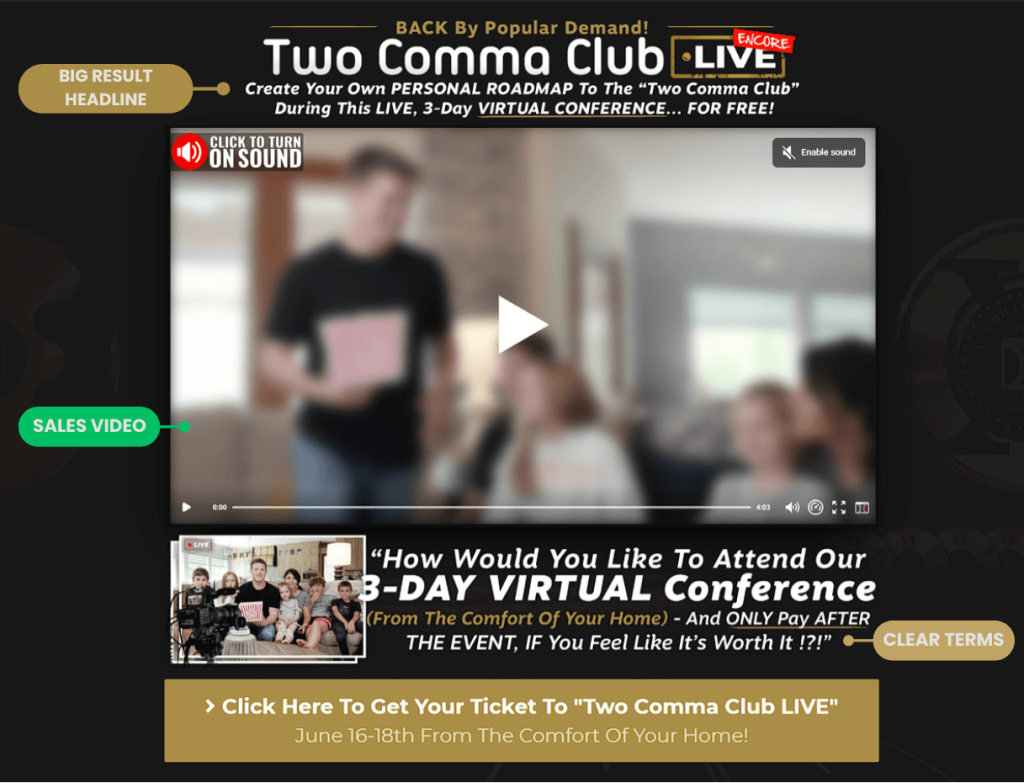
Notice how it specifies exactly what you’ll get (a roadmap), where you’ll get it (3-day virtual conference), and the cost (free).
For your terms section, spell out the process in 3 steps:
- Step 1: Put in your credit card to reserve your virtual seat.
- Step 2: Attend the 3-day online virtual conference.
- Step 3: After experiencing everything, decide if it was worth it. If yes, you’ll be billed $197 automatically. If not, just email a specific address, and you won’t pay anything.
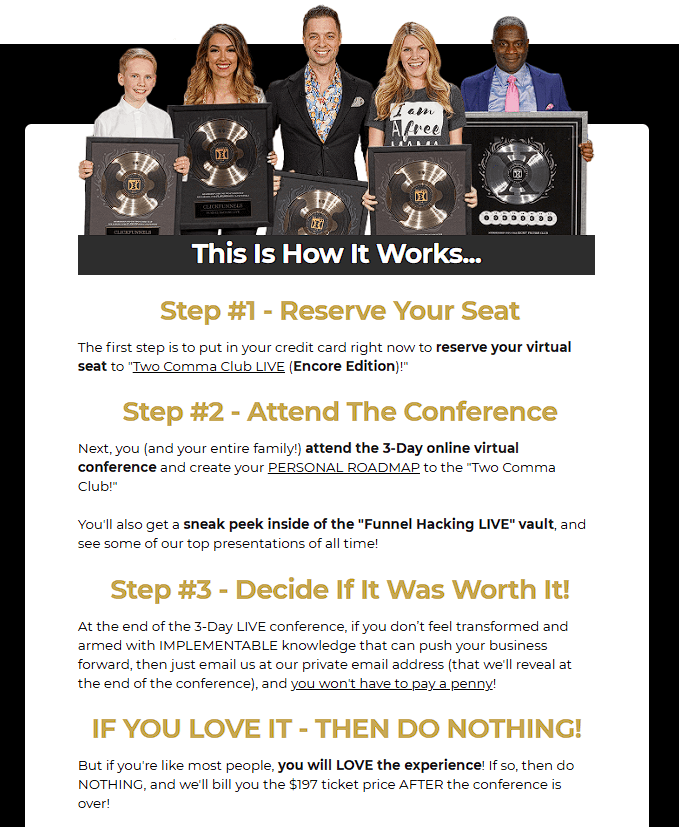
For your sales video and sales letter (sales page content), you have several proven scripts to choose from:
- The Original Story script (shows your journey)
- Start, Story, Solution script (problem → journey → answer)
- Hero’s Two Journeys Script (transformation-focused)
- or The Epiphany Bridge script (your “aha” moment)
💡 Pro Tip: You can learn about these scripts inside the Dotcom Secrets book or use Funnel Scripts software to generate them in 5 minutes (or less). Watch the video demo here.
Order Form With Upsell Box
You will want to add two options right here:
- Option 1: Free now and pay later
- Option 2: Pre-pay now with a discount (plus maybe a bonus).
Remember how I mentioned the Invisible Funnel filters out freebie seekers and increases your webinar attendance rate? Here’s why it works so well.
When someone enters their credit card, they’ve mentally committed to showing up.
Think about your own behavior. When was the last time you registered for a “free” webinar and ghosted it? Probably recently. But if you had to enter your credit card? You’d be there early with your notepad ready.
People simply value what they might pay for more than what’s totally free.
If a customer prepays, they’re almost guaranteed to show up – they’ve already invested money with no refund option.
Here’s what’s shocking: 70-80% of people choose the prepay option! This means you make serious cash upfront on what’s technically a “free” offer.
This one change transforms your cash flow overnight. Instead of waiting to bill people later (and dealing with cancellations), you collect money the moment people register.
Look at Russell Brunson’s approach – he offers $50 off for people who prepay ($147 instead of $197) and throws in the event replay as a bonus.
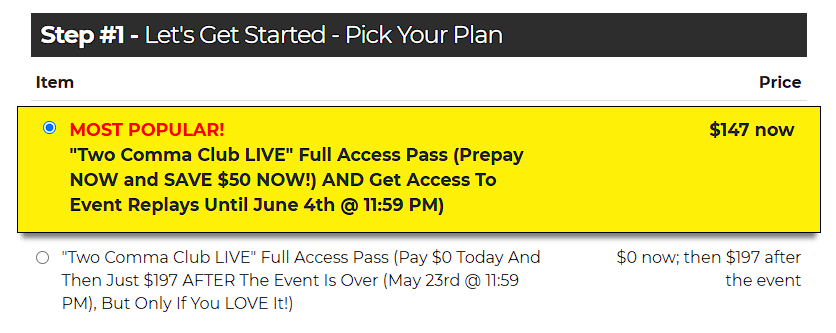
Next, you’ll want to add an order bump here to increase cart value.
In this case, Russell Brunson offers the Secrets Trilogy Box Set for $97.

This single change revolutionizes your cash flow.
Instead of waiting to bill people later (and dealing with potential cancellations), you collect payment the moment people register.
With the prepay option and upsell box combined, you can pay for your ads and generate some profits right away.
The Upsell Page
Similar to other types of sales funnels, you’ll want to add a series of upsell pages after someone registers for your webinar.
This makes perfect sense when you think about it. The person just pulled out their credit card and made a purchasing decision. They’re in a buying mindset right now – not tomorrow, not next week, but right now.
Adding 1-2 carefully selected upsell offers gives them the chance to solve related problems immediately. For the Invisible Funnel model, these might be complementary courses, tools, or resources that help attendees get more from your upcoming webinar.
Keep these upsell pages simple and focused on a single offer. You don’t need fancy tactics here – just a clear explanation of how this additional resource helps them achieve their goals faster.
Thank You Page With The Offer Wall
The thank you page is your chance to both confirm their registration and make additional offers. Start with an order summary section that clearly shows what they’ve purchased and what they’ll be billed for (and when).
Next, provide crystal-clear instructions on how to access your content.
For live webinars, include the exact date and time (in multiple time zones), along with a calendar add button so they can schedule it immediately. For recorded training, give simple, step-by-step access instructions with screenshots if needed.
Fast fact: Most people will never return to your website again. The thank you page might be your only chance to introduce additional offers.
This is why you need to create two different versions of your thank you page:
- For customers who purchased your upsell: Show them complementary offers or the next step in your value ladder
- For customers who didn’t purchase: Present your upsell offer again with a slightly different angle, emphasizing what they’ll miss without it
Both versions should maintain the same clear instructions for accessing your webinar or training – that’s the primary purpose of the page.
The offer wall is secondary but can dramatically increase your revenue when done right.
Webinar Room/Member’s Area
Finally, you drive people to the webinar or the member’s area page.
No matter which route you take, the primary rule here is simple: Deliver massive value to your customers as promised.
If you fall short, you’ll face a flood of cancellations and refund requests (even when you didn’t officially offer money-back guarantees), leading to complaints that can damage your reputation for years.
Is a webinar or member’s training better?
It really depends on what you teach and your personal style.
A 3-day live training event works beautifully because it gives you enough time to build substantial value and a relationship with customers. Similarly, a focused 3-4 hour webinar can be just as effective for more concentrated topics.
Based on my experience, 85% to 90% of registrants who attend these webinars will show up (compared to 20-30% for free webinars), and they stay for the full four hours.
Why? Because they’ve paid for it.
They’ve invested money, and they’re committed to getting their value.
At this point, besides delivering what you promised, you’ll want to promote your high-ticket offers. The best time to sell something is after customers have experienced an amazing result and you have the next thing they need.
Offering your premium programs at the end of an Invisible Funnel webinar is incredibly effective precisely because they’ve already received substantial value and seen proof of your expertise.
Keep in mind that people paid money for this webinar or training.
The big red flag is spending half your time talking about yourself or aggressively promoting your product instead of delivering value.
Your paid attendees deserve better. That said, a well-structured offer at the end feels natural when they’ve already gotten what they paid for.
Pro tip: Get the Perfect Webinar Secrets to learn how to build a compelling presentation that both delivers huge value and smoothly promotes your high-ticket offer without feeling pushy. This framework has helped countless entrepreneurs turn webinars into profitable high-ticket sales machines.
Important: Remember to clearly instruct people on how to cancel their card at the end of the webinar if they didn’t find the content valuable. This should be bold, straightforward, and impossible to misunderstand. Consider creating a simple Google form for submitting cancellation requests or setting up a dedicated support email address for this purpose.
Application Page
For customers who are ready to invest in your high-ticket program after your webinar, you’ll direct them to an application page.
(Skip this step if you didn’t promote anything in your webinar.)
The application is designed to help you understand more about potential clients you’ll be working with and determine if your product or service is truly the right fit for them. This isn’t just a formality – it’s a crucial qualifying step that benefits both you and the applicant.
Next, you’ll transition these qualified leads from your sales funnel into your pipeline, where your sales team will contact them to discuss their needs and close the deal.
Keep your application focused and purposeful. Only collect information that will genuinely help your sales team understand potential clients – their background, specific challenges, financial situation, goals, or anything else that will help your team prepare for a productive conversation. Unnecessary questions just create friction and reduce completion rates.
That’s an invisible funnel. It works amazing and is one of the best funnels you can use!
The Invisible Funnel Drawback: The #1 Reason Why Most People Don’t Use It
While the Invisible Funnel is incredibly powerful, you might wonder why you don’t see it everywhere.
I was surprised myself – this strategy has been around since Russell Brunson first introduced and popularized it in the first edition of his best-selling book “Dotcom Secrets.”
Yet despite its effectiveness, lead magnet funnels and standard webinar funnels remain far more common in the marketing world.
The #1 reason most marketers don’t implement the Invisible Funnel is that setting up the payment process is technically challenging.
The Invisible Funnel works by having people sign up for free, but charging their cards after your event or training X days (unless they cancel).
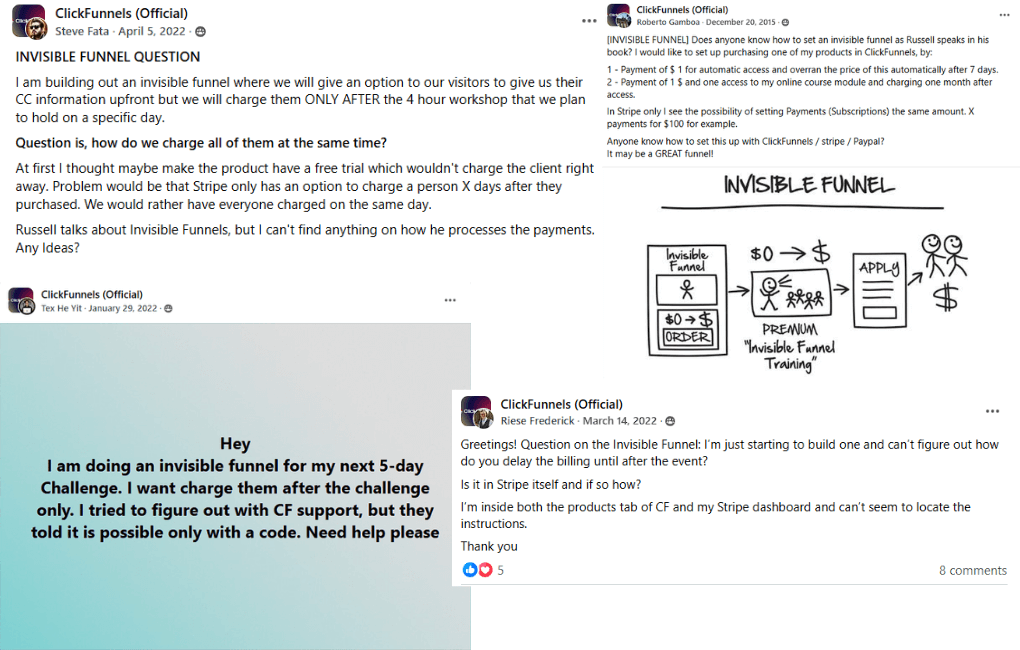
The problem? Most payment systems and funnel builders just weren’t built for this.
When you set up payments online, you typically only get three options:
- One-Time Price: Single upfront payment.
- Subscription: Recurring payment for service or membership (e.g, $15/month or $997/year)
- Payment Plan: Such as 3 or 4 monthly payments.
None of these options work perfectly for the “collect card now but maybe charge later on a specific day” approach that the Invisible Funnel requires.
For a long time, getting this type of payment structure to work without knowing how to code was extremely difficult. You’d need to cobble together different systems or hire someone to build a custom solution.
This technical roadblock is why, despite its amazing results, the Invisible Funnel remains less popular than simpler marketing approaches.
How To Create An Invisible Funnel? (Step-By-Step)
Let me show you exactly how to build your own Invisible Funnel from scratch. I’ve broken everything down into simple steps that anyone can follow.
Preparation Steps: Getting Your Tools Ready
Before you start building your funnel, here’s what you’ll need:
I use Clickfunnels for all my Invisible Funnels because it just works. It’s simple enough for beginners but powerful enough to handle this special type of funnel. If you don’t like Clickfunnels, you can pick another funnel builder from this list. Just make sure it can do the things I’ll show you in the next sections.
Not sure about Clickfunnels? Check out my honest Clickfunnels review here to see if it’s right for you.
Getting these basics ready now will make the rest of the process much smoother. Trust me – I’ve learned this the hard way!
Step #1: Create Your Invisible Funnel’s Product
Now let’s set up the actual products inside Clickfunnels that will power your Invisible Funnel. Don’t worry – this is easier than it sounds.
First, head to your ClickFunnels dashboard.
Look for the “Products” button, then select “All Products” from the dropdown. Now hit the “Create Product” button.
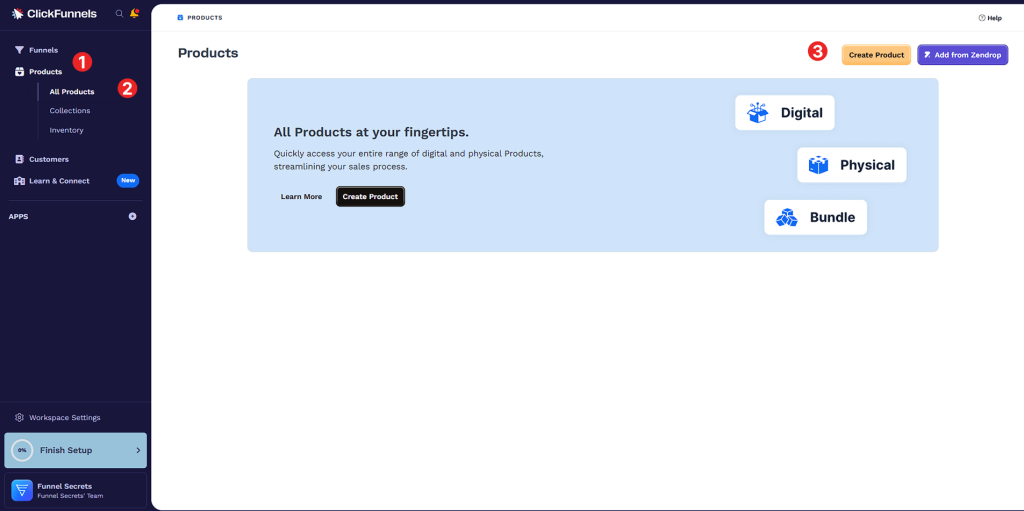
When asked about product type, choose “Digital” since we’re selling digital content.

Give your product a name and description – nothing fancy needed here, you can always change these details later.
For my example, I created a dating product called “The Connection Code: 4 Hours to Dating Mastery.” This product has two pricing options:
- Free registration now, but a $97 charge after the event
- Pre-pay now option at $67 (saving $30)
My event starts on June 5th. I’ll start promoting on May 28th, and customers who choose the free option will be charged on June 7th at 11:59 PM (2 days after the event).
For this setup, we need to create two separate products – one for the pre-pay option and another for the free-now-pay-later option.
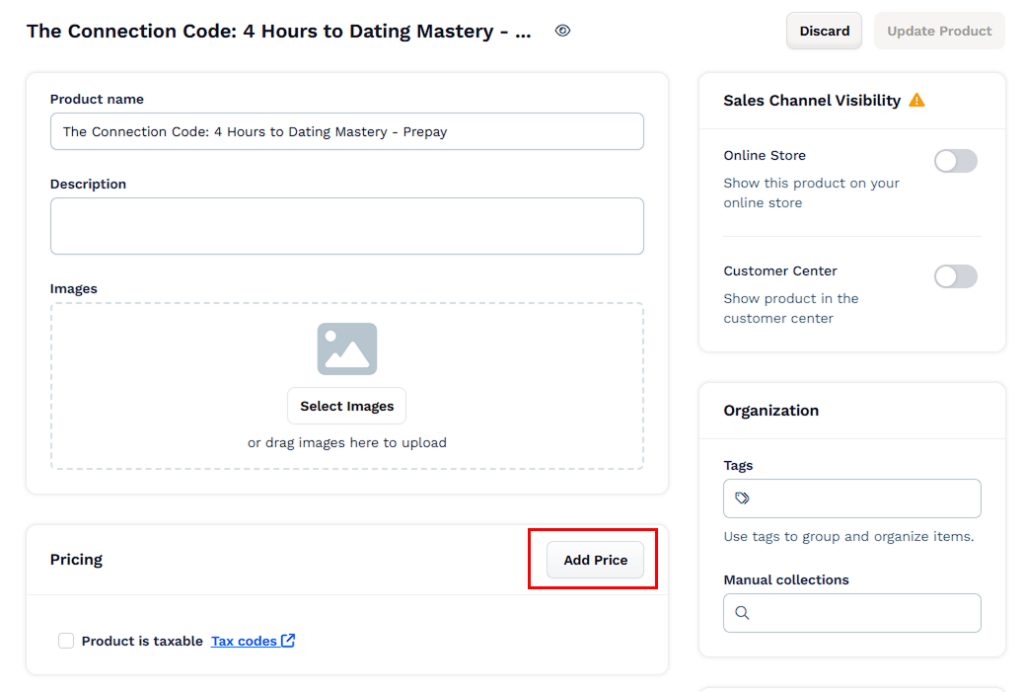
Let’s create the pre-pay product first:
- Choose “One time” for Price type
- Set the “Amount” to your discounted price ($67 in my case)
Configure the rest of the settings as shown in the image below.
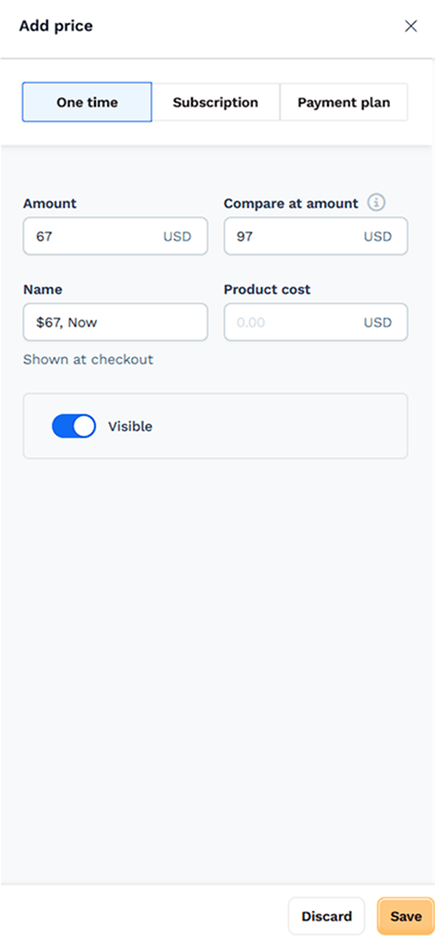
Turn OFF the “Page Live Mode” – we need to test everything in test mode first.
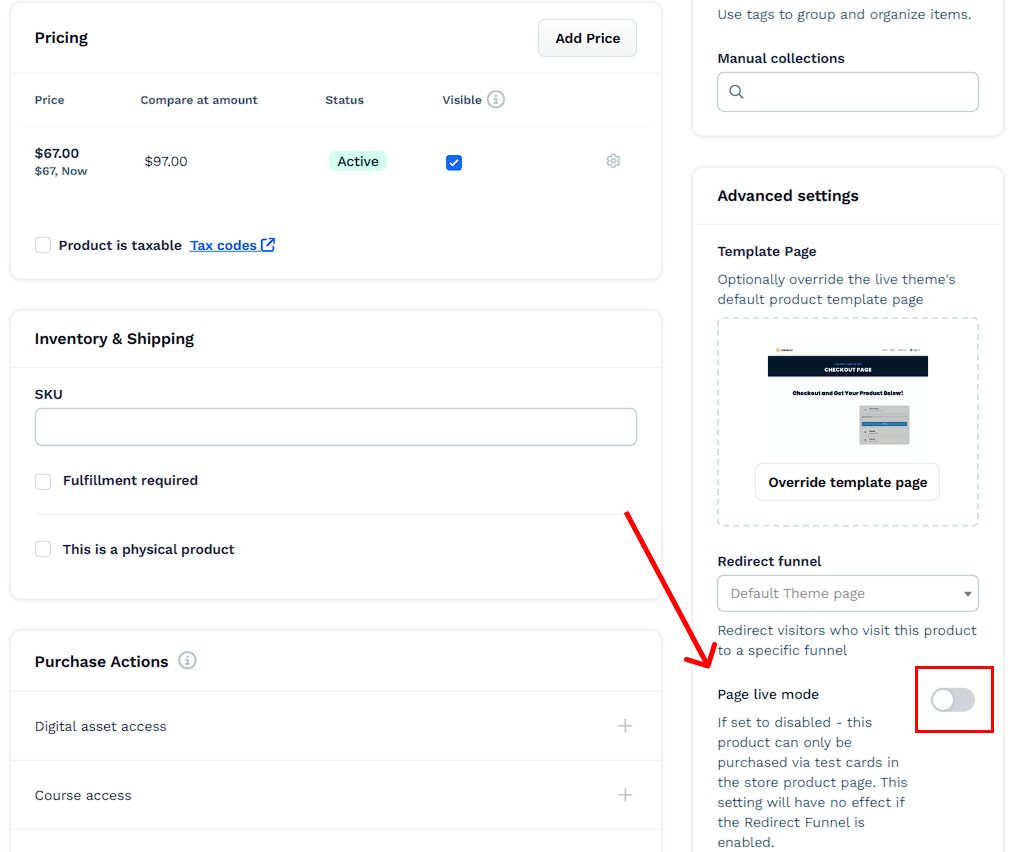
Next, create the second product for the free-now-pay-later option:
- Choose “Subscription” for Price type
- Check the box for “Product has a trial.”
- Set the trial length to cover your event period (I used 10 days)
- Set “Amount per payment” to your full price ($97 in my case)
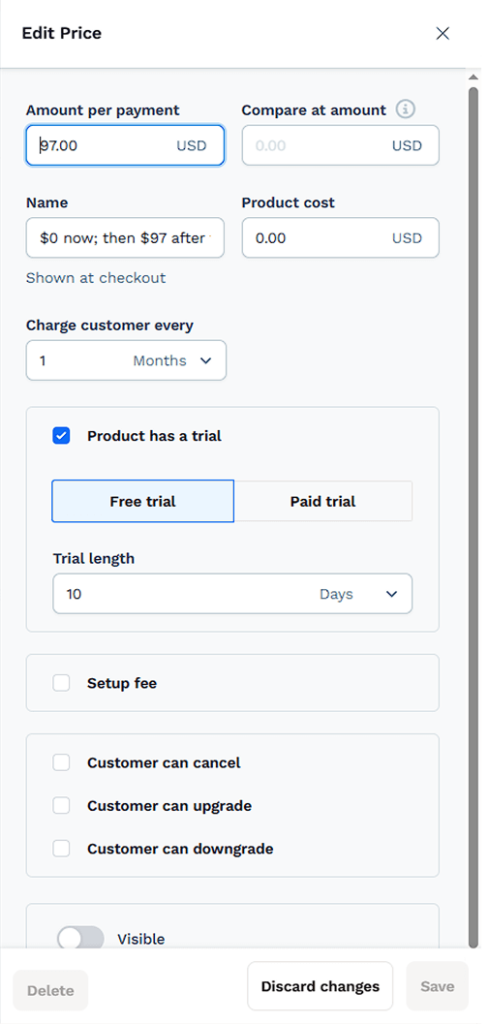
Add Organization tags, then save all changes.
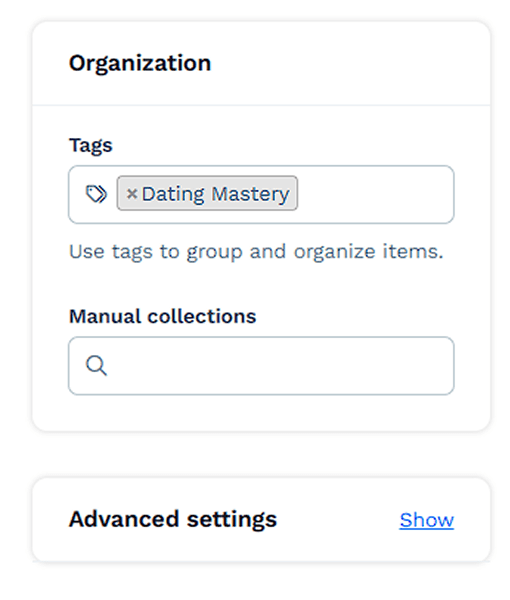
Here’s a small issue: if someone signs up on June 4th (one day before the event), they’d be charged on June 14th using the 10-day trial setting. But we want everyone charged exactly 2 days after the event.
Don’t stress about this – I’ll show you a simple fix later.
That’s it!
Your Invisible Funnel products are ready.
I’m not covering order bumps or upsell pages here since they’re pretty straightforward to create in the product section. If you need help with those, check out Clickfunnels’ tutorial.
Step #2: Create Landing Pages in Your Invisible Funnel
Now let’s build the actual funnel pages that will convert visitors into customers. This is where the rubber meets the road.
Inside your Clickfunnels dashboard, click on “Funnels” and then hit “Create Funnel.”
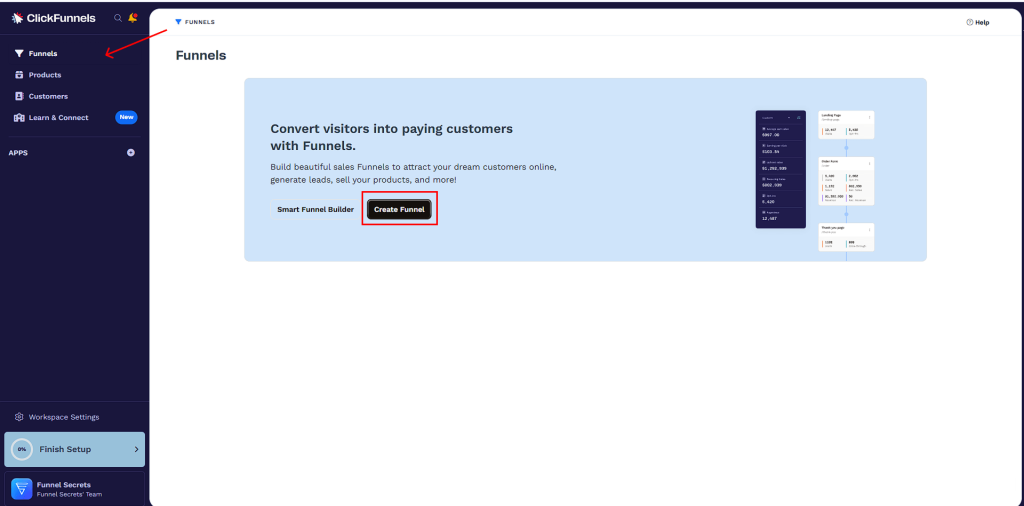
You’ll see two options: Choose from proven funnel templates or start from scratch.
If you’re new to this, I suggest choosing either the Cart Funnel or Video Sales Letter Funnel template and tweaking it to fit our needs.
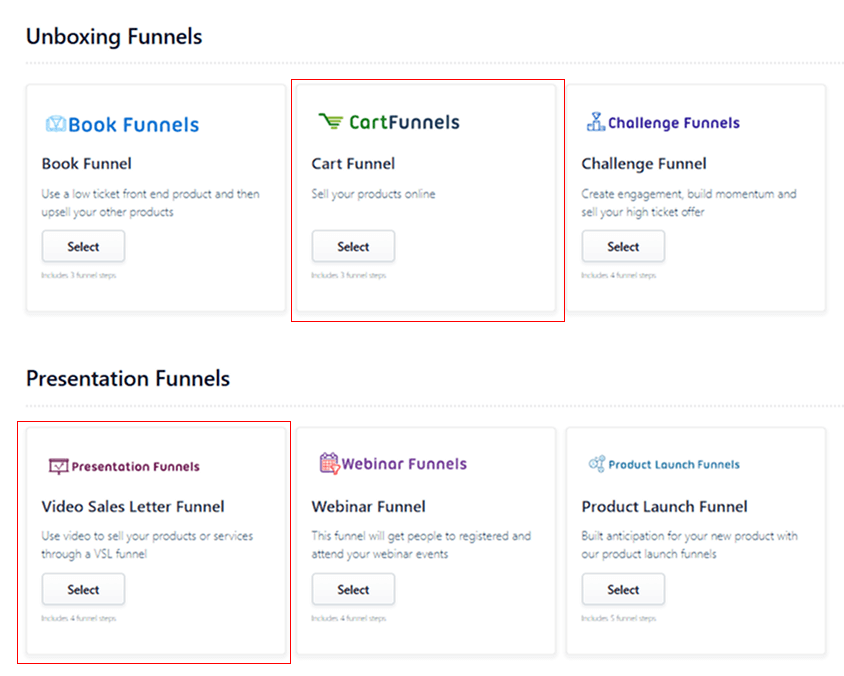
For this guide, I’m building from scratch.
Give your funnel a name and URL path, then click “Create Funnel.”
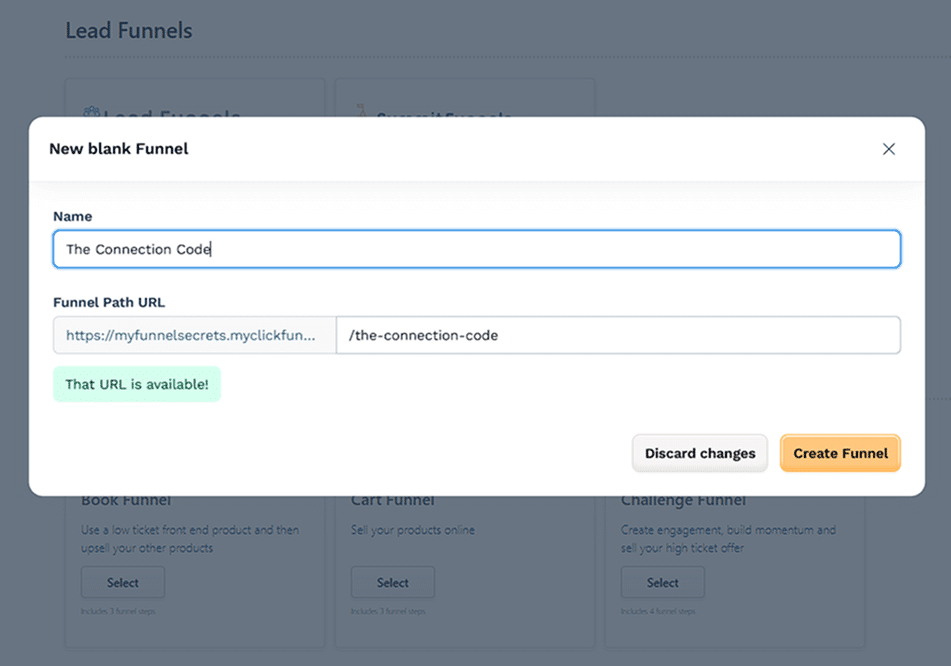
I won’t dive deep into creating each page, since you can learn more about that in my other articles.
Besides, you can follow the video tutorial here to setup your sales funnel pages.
The basic flow of an Invisible Funnel looks like this:
- Sales page with order form (or a separate order form page)
- Upsell page
- Thank you page
For delivering your training, you can create a membership site right in Clickfunnels. If you’re hosting a live webinar, you can use platforms like WebinarJam, EverWebinar, Zoom, or any other that works for you.
The most important part is connecting your products to the order form. Here’s how:
Inside your Order Page, click on the “Checkout” element -> “Product select.”
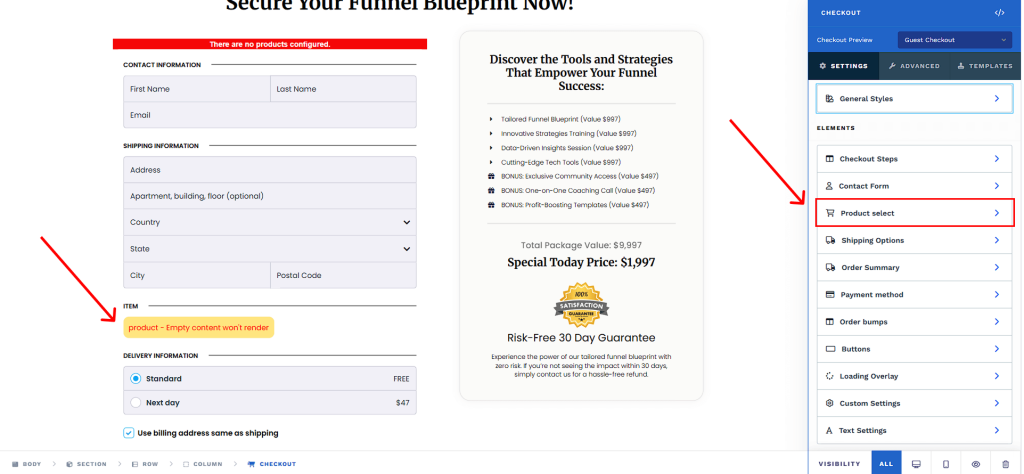
Hit “Edit Product.”
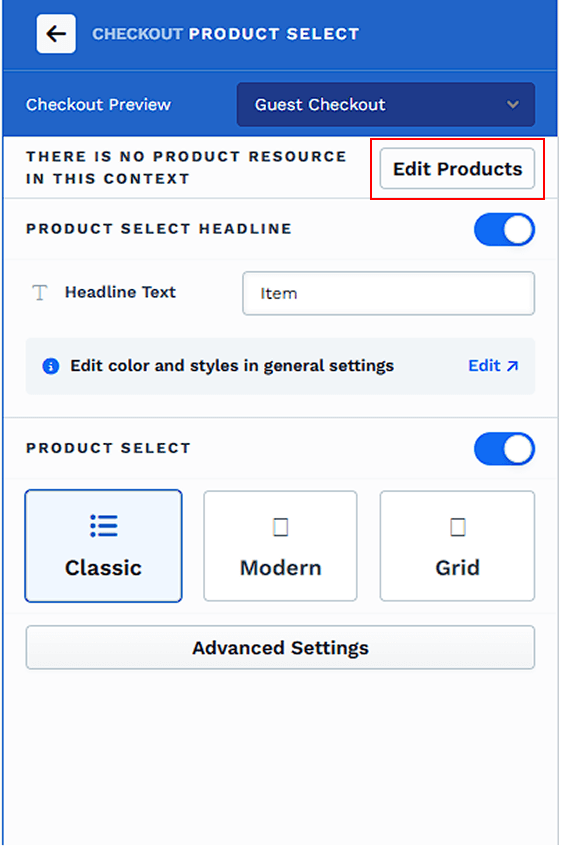
Click “Add product” and Select the products we created earlier

Now let’s make the product options crystal clear for customers (like Russell Brunson does). To customize how they appear:
- Click “Edit product” again
- Click the ⚙️ gear icon to override the title and description

For the free-pay-later option, I put a “Space” in the title override section and adjusted the description to explain the terms
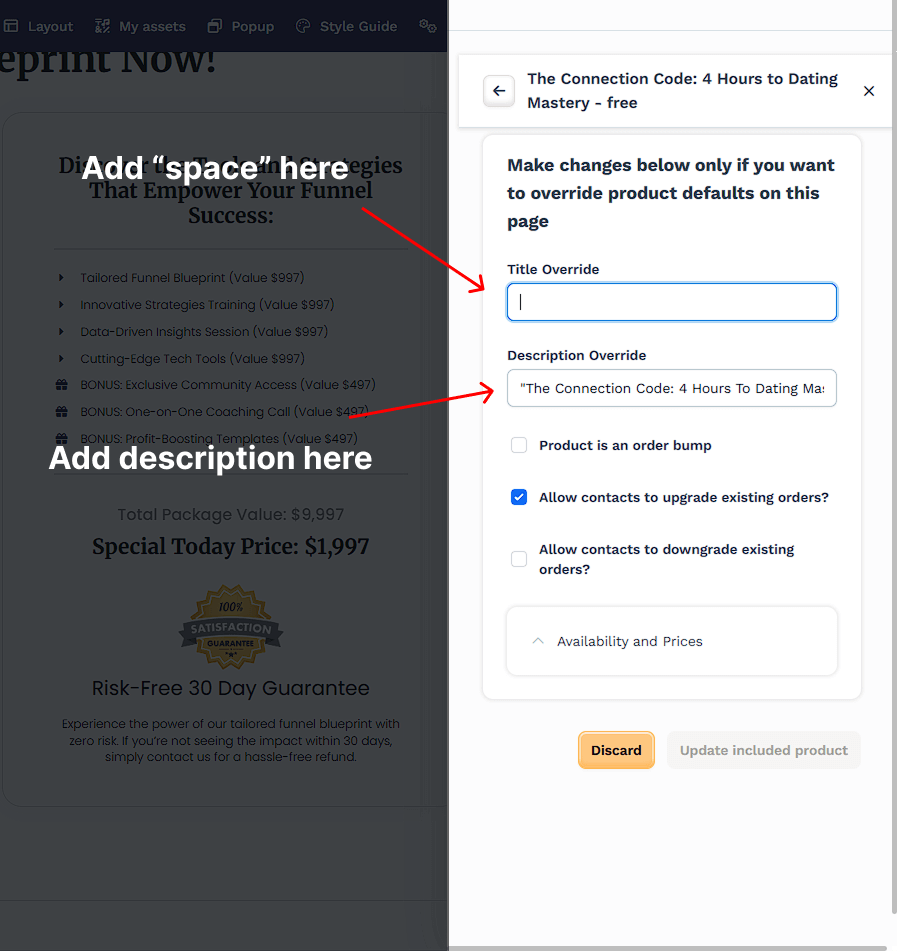
For the pre-pay option, I override the title to highlight the $30 savings and mention they get replay access until June 20th at 11:59 PM.
Here’s the result!
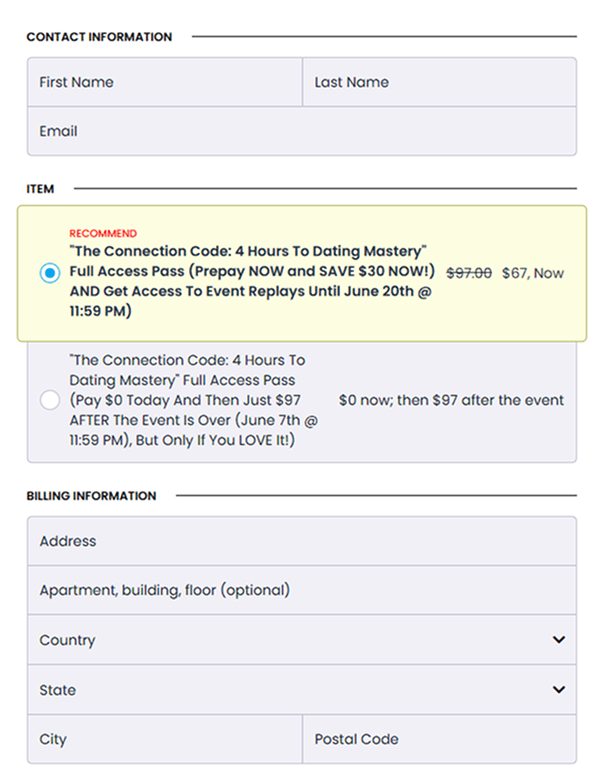
That’s it! Your pages are set up, and product options are connected.
Now we’re testing your funnel to make sure everything works properly.
Step #3: Testing Your Funnel
One of the best things about Clickfunnels is the Test Mode feature. This lets you check if your entire sales process works properly before going live.
Before we start, make sure you’ve turned on “Test Mode” in your funnel settings.
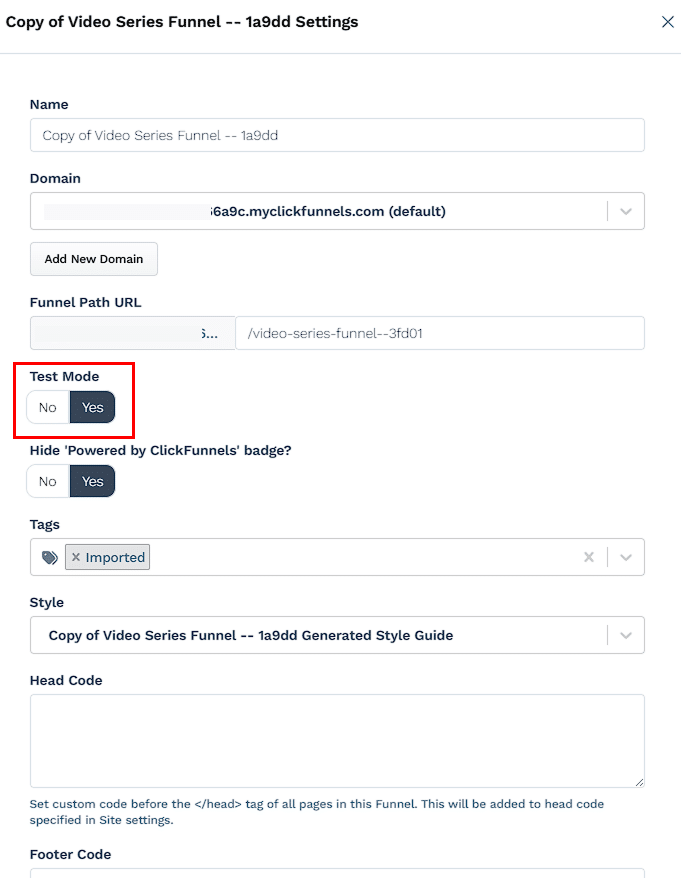
Now, let’s test the order form with the free-now-pay-later option.
Clickfunnels provides special test credit card numbers you can use without charging real money.
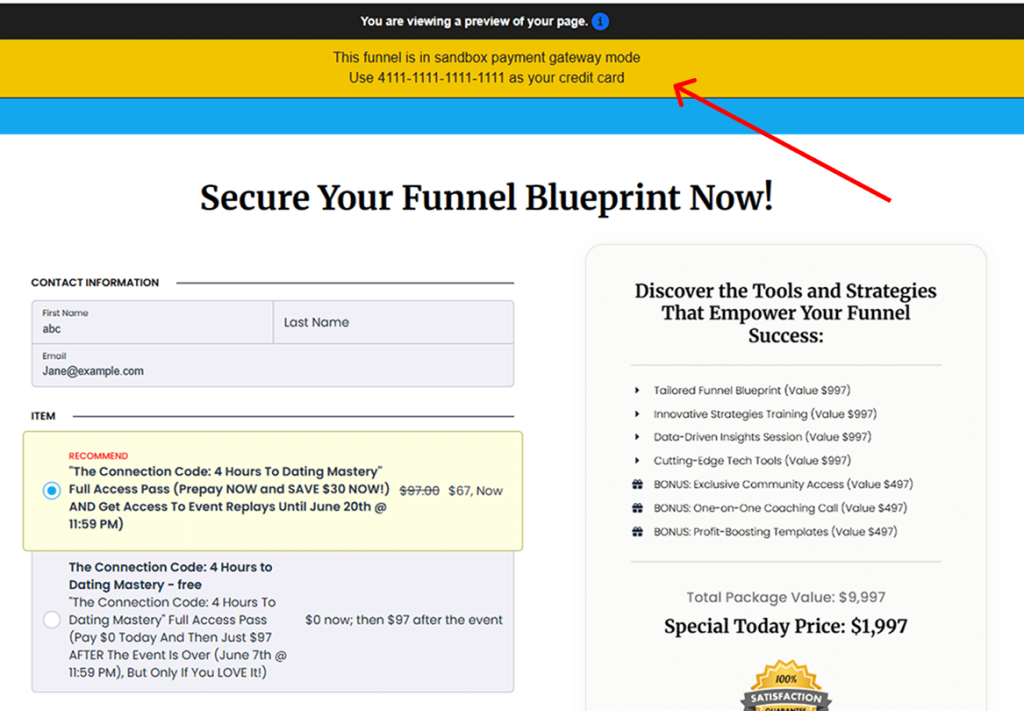
You can enter any information in the form fields along with the test card number to simulate a real customer purchase.
Go through the entire funnel as if you were a customer.
Fill out the form, select the free option, enter the test credit card, and complete the purchase. Then do the same for the pre-pay option.
Check every page of your funnel to make sure:
- Both product options display correctly
- The checkout process works smoothly
- Upsell pages appear as expected
- Thank you page loads with the right information
- Any email confirmations are sent properly
Once you’ve tested everything and confirmed it’s working properly, we can move to the next step: setting up the system to charge your free trial customers on the specific date after your event.
⚠️ Important: Always disable Test Mode before launching your funnel live
Step #4: Charge Customers on a specific date
Now for the interesting part.
Remember how I mentioned most marketers don’t use the Invisible Funnel?
The BIG problem is that they don’t know how to set up a system where people can input their card for free access, but get charged exactly X days after the event.
This step comes after you’ve made your funnel public and people have started signing up with the free option for your webinar.
Here’s the simple solution:
- Inside your Clickfunnels dashboard, click on “Customers” in the left navigation
- Go to the “Orders” tab
- Filter the Order Status to show only “trialing” orders
- Click on the Order Number to see the full order info
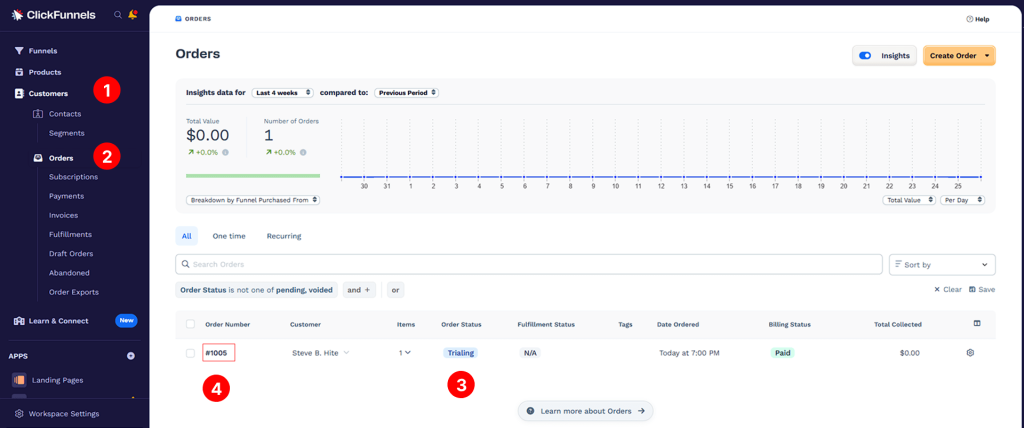
On the right side of the screen, you’ll see a “Manage Subscription” button.
Click on it, then select “Change trial end date.”
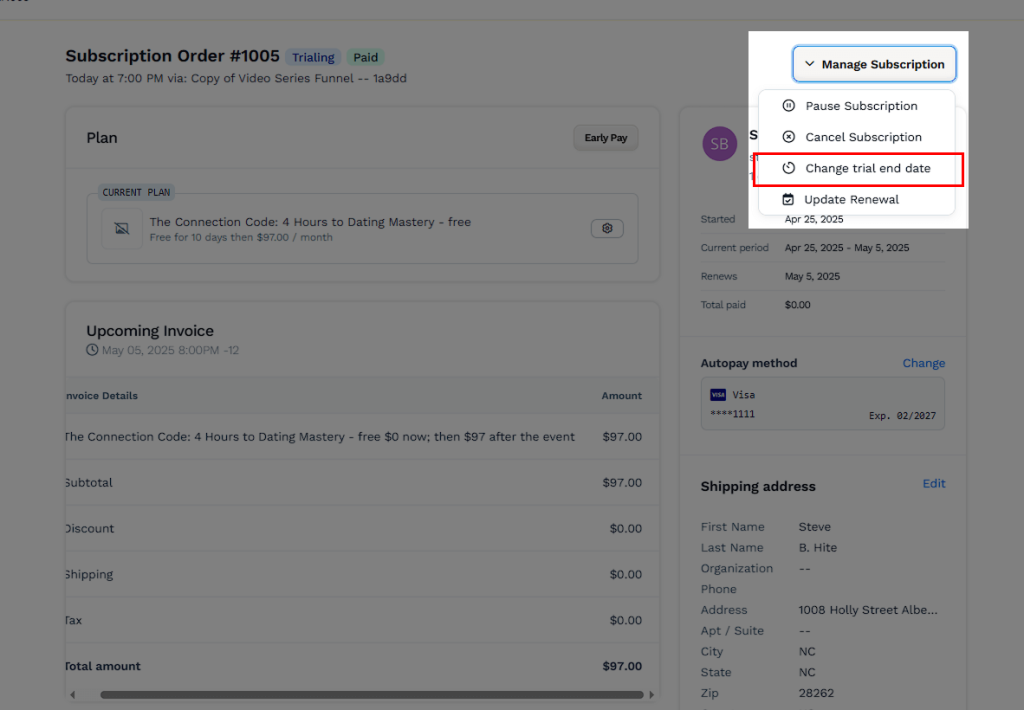
From there, you can change the trial end date to exactly when you want to charge them.
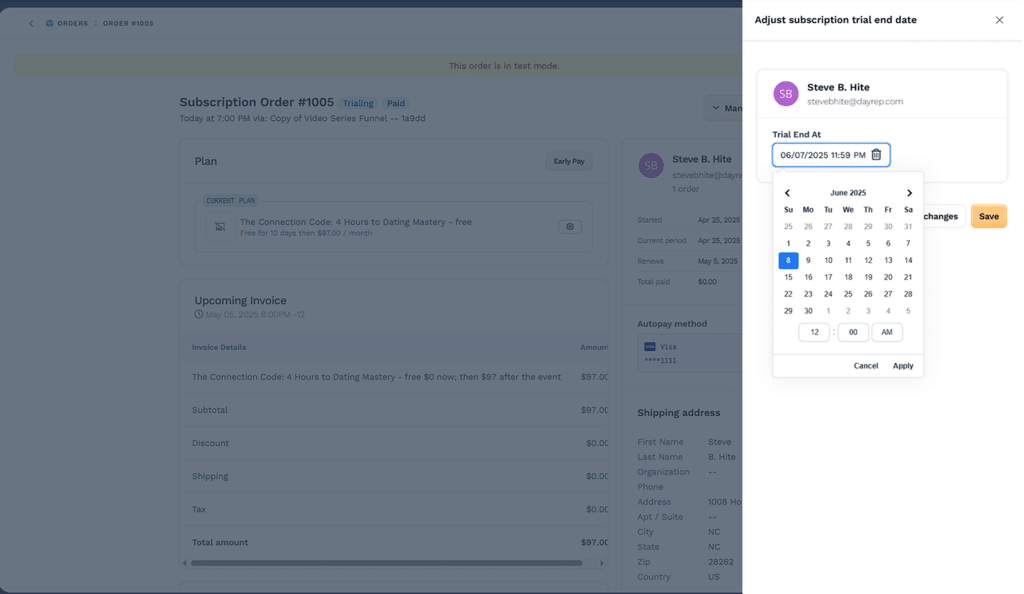
In our example, we’d set it to June 7th at 11:59 PM (exactly 2 days after the June 5th event).
That’s it!
The customer will be charged automatically at the exact date and time you set.
The only drawback is that you need to change this manually for each customer. You can either hire a virtual assistant to handle this task or do it yourself if you don’t have too many customers.
Conclusion
Thanks for sticking with me through this Invisible Funnel guide.
You now have everything you need to implement one of the most powerful but underused funnel strategies out there.
To recap what makes the Invisible Funnel so special:
The Invisible Funnel lets you collect payment information upfront for “free” content, but customers are only charged if they find value in what they received. This approach builds trust, relationships, and authority fast.
Unlike traditional funnels, which ask for the sale immediately, the Invisible Funnel gives people a taste of your best content without any risk. When they experience real value, they’re happy to pay – often at higher conversion rates than standard funnels.
The technical piece that kept most marketers away is now solved with the simple Clickfunnels approach I showed you. While it requires a small manual step, the results make it more than worthwhile.
If you want to learn more about Invisible Funnels straight from experts, check out the Dotcom Secrets summit, where Daegan Smith shares even more advanced strategies.
Want to explore other powerful funnel types? Grab your free copy of the Funnel Hackers Cookbook – it’s packed with proven funnel templates that have generated millions in sales across countless industries.
Now it’s your turn to put this knowledge into action. Your first Invisible Funnel is just a few clicks away!

Author
Key Nguyen
Key is the brainchild behind Funnelsecrets.us. You’ll often find him analyzing conversion rates, tweaking landing pages, and exploring new marketing automation software. He loves to write about sales funnel building and is always tinkering with the latest conversion optimization techniques!
